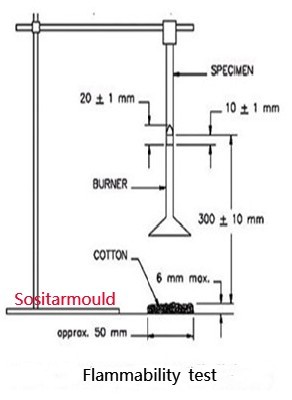UL94 is one of the most widely applied flammability tests for determining the flammability of plastic materials, which – based on burning speed, burning time and dripping behavior (anti-drip ability and whether particle drops are burning) – measures the ability of the plastic material to extinguish the flame after it is ignited. Many values can be obtained for each tested material according to color or thickness. Therefore, when selecting the material for a certain product, its UL rating should meet the requirements for plastic product wall thickness. The UL rating should be reported in combination with thickness, since UL rating without thickness will not suffice.
An Introduction to Ratings
The fire ratings of plastic materials gradually increase from HB, V-2, and V-1 to V-0:
HB: The lowest fire rating in the UL94 flammability standard. It is required that for specimens with a thickness of 3-13mm, burn rate should be less than 40mm per minute; and for specimens with a thickness of less than 3mm, burn rate is less than 70mm per minute, or flame is extinguished before the 100mm mark.
V-2: After two 10-second burning tests are performed on the specimen, the flame is extinguished within 30 seconds, and able to ignite the cotton wool located 30cm below.
V-1: After two 10-second burning tests are performed on the specimen, the flame is extinguished within 30 seconds, and unable to ignite the cotton wool located 30cm below.
V-0: After two 10-second burning tests are performed on the specimen, the flame is extinguished within 10 seconds.
Testing Methods
UL94 flammability test includes the following 4 methods:
1. Horizontal burning test for UL94 HB rated materials;
2. Vertical burning test for UL94 V-0, V-1, and V-2 rated materials;
3. Vertical burning test for UL94 5V rated materials;
4. Vertical burning test for UL94 VTM-0, VTM-1 and VTM-2 rated materials.
Standard Procedure
Basic Information
UL94 HB
Specimen: 5″ × 1/2″ × thickness (typical thickness = 1/16″, 1/8″, 1/4″)
Procedure:

Three specimens of each thickness are to be tested. Before the test, the specimens are placed under 20°C & 50% RH conditions for 48 hours, parallel to the long axis and at a 45° angle to the short axis. For each specimen, draw two lines respectively 1″ and 4″ long from one end, place a 1″ high blue flame at the end of the specimen that is suspended in the air, burn it for 30 seconds and then remove the flame. If the specimen continues to burn after the flame is removed, measure the burning time of the specimen between the two width marks, and burn rate is calculated by inches per minute.
Rating Requirements:
94HB
A: For specimens with a thickness between 0.120″ and 0.500″, the burn rate cannot exceed 1.5″ per minute, i.e., spanning greater than 3.0″, or
B: For specimens with a thickness of 0.120″, the span cannot exceed 3.0″, or
C: Before the flame reaches the 4.0″ mark, the specimen ignites spontaneously.
UL94 V-0 / V-1 / V-2

Specimen: 5″ × 1/2″ × thickness (typical thickness = 1/16″, 1/8″, 1/4″)
Procedure:
A total of 10 specimens (2 sets) are tested for each thickness. 5 specimens of each thickness are tested after being placed under 23°C and 50% RH conditions for 48 hours. 5 specimens of each thickness are tested again after being placed under 70°C conditions for 7 days.
The specimen is placed and installed perpendicular to the long axis. When installing, keep the lower end of the specimen 3/8″ away from the top of the combustion tube. Place a 3/4″ high blue flame at the center of the lower end of the specimen and burn for 10 seconds.
If the specimen drips drop by drop, the liquid will fall on the layer of unsurgically treated cotton placed 12″ below the specimen.

Rating Requirements:
94 V–0
A: No specimen burns with flame for more than 10 seconds after the test flame is removed;
B: For each set of 5 specimens, after 10 ignitions, the total time of burning with flame does not exceed 50 seconds;
C: No specimen burns with flame spreading to the fixture;
D: No specimen produces flaming dripping that ignites the cotton located 12″ below;
E: No specimen continues to burn with glowing combustion for more than 30 seconds after the 2nd removal of the test flame.
94 V–1
A: No specimen burns with flame for more than 30 seconds after the test flame is removed;
B: For each set of 5 specimens, after 10 ignitions, the total time of burning with flame does not exceed 250 seconds;
C: No specimen burns with flame spreading to the fixture (including flaming and glowing combustion);
D: No specimen produces flaming dripping that ignites the cotton located 12″ below;
E: No specimen continues to burn with glowing combustion for more than 60 seconds after the 2nd removal of the test flame.
94 V–2
A: No specimen burns with flame for more than 30 seconds after the test flame is removed;
B: For each set of 5 specimens, after 10 ignitions, the total time of burning with flame does not exceed 250 seconds;
C: No specimen burns with flame spreading to the fixture (including flaming and glowing combustion);
D: Allow specimen to produce flaming dripping that ignites the cotton located 12″ below, but the cotton only burns for a very short period of time;
E: No specimen continues to burn with glowing combustion for more than 60 seconds after the 2nd removal of the test flame.
